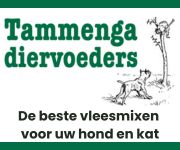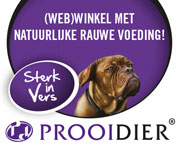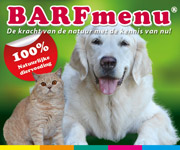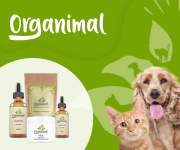Whole Dog Journal July 2006
A profile of Juliette de Bairacli Levy, pioneer of natural rearing methods.
By CJ Puotinen

Juliette de Bairacli Levy and one of her home-bred and holistically raised Turkuman Afghans in the 1960s.
Readers of canine health books and magazines, including this one, can be forgiven for assuming that holistic or natural pet care is a recent breakthrough, something developed during the past two or three decades by a handful of revolutionary veterinarians and researchers.
Not so. Today’s holistic pet care movement began over 70 years ago when Juliette de Bairacli Levy defined “natural rearing.” Now in her 90s and living in Switzerland, Levy holds a place of honor in the history of natural pet care.
Born to a wealthy Jewish family (her father was Turkish, her mother Egyptian) and raised in England with chauffeurs, maids, cooks, and gardeners, Levy knew in childhood that she wanted to be a veterinarian. She attended two universities and was in her final year of veterinary school when she decided that conventional medicine had none of the answers she sought, and she embarked on a lifetime of travel and study with nomadic people, first in England, then around the world.
“I realized that if I wanted to learn the traditional ways of healing and caring for animals, I had to be where people still lived close to the land and close to their flocks,” she says. “From Berbers, Bedouins, nomads, peasants, and gypsies in England, Israel, Greece, Turkey, Mexico, and Austria, I learned herbal knowledge and the simple laws of health and happiness. I never tired of traveling with my Afghan Hounds, always living with and learning from those around me.”
An inexhaustible writer, Levy shared what she learned in letters, travel books, novels, poems, and books about herbs and animals. In the 1930s, she published three canine herbals. The Cure of Canine Distemper described protocols she developed for her highly successful distemper clinic in London. Puppy Rearing by Natural Methods and Medicinal Herbs: Their Use in Canine Ailments were reprinted for a wider audience in London in 1947. All three were soon translated into German and other languages.
Just over 50 years ago, in 1955, she combined these works in The Complete Herbal Book for the Dog. Now in its sixth edition and called The Complete Herbal Handbook for the Dog and Cat, this is the book that brought Levy’s natural rearing philosophy to breeders, trainers, and dog owners throughout the world.
Five rules of natural rearing
Levy’s basic rules of natural rearing for dogs require:
1) a correct natural diet of raw foods;
2) abundant sunlight and fresh air;
3) at least two hours of exercise daily, including plenty of running exercise outside any kennel enclosures;
4) hygienic kenneling, with the use of earth, grass, or gravel runs, never concrete; and
5) herbs, fasting, and other natural methods in place of vaccinations and conventional symptom-suppressing drugs.
Levy’s first rule has gained acceptance over the years. Many holistic veterinarians recommend feeding a home-prepared diet of raw foods, including meat and bones. Some use the diet of wild wolves as a model. Levy and her followers feed a variety of foods, including raw meat, dairy, eggs, minced herbs, and small quantities of fruit, vegetables, powdered seaweed, and grains such as oats soaked overnight in raw goat milk or yogurt.
“I introduced seaweed to the veterinary world when a student in the early ’30s,” she says. “It was scorned then, but now it is very popular worldwide.” She credits kelp and other sea vegetables with giving dark pigment to eyes, noses, and nails, stimulating hair growth, and developing strong bones.
In addition to providing ample quantities of pure water at all times, Levy recommends one meatless day and one fasting day (no food, just water) per week for adult dogs. Where raw bones are concerned, Levy recommends feeding them after the day’s main meal, on a full stomach, so that the bone is cushioned by food, and with a small amount of soaked bran, shredded coconut, or other fiber to help sweep bone fragments from the digestive tract.
All of Levy’s dietary recommendations are accompanied by traditional herbal formulas for everything from daily health maintenance to birthing aids and weaning foods, disinfecting herbs that help protect dogs from harmful viruses, bacteria, and parasites, and herbal first-aid for dozens of conditions and illnesses.
Researchers who study the connection between natural light and the endocrine system agree with Levy’s recommendation that dogs spend as much time as possible outdoors. They blame malillumination, the lack of unfiltered natural light, for a host of chronic illnesses. Glass windows prevent the transmission of full-spectrum natural light, but open windows and doorways provide it.
Daily outdoor exercise, including running and play, does more than burn calories; it stimulates lymph circulation, strengthens bones, improves immunity, and keeps dogs happy as well as healthy.
Levy’s advice about kenneling dogs in close contact with earth or grass rather than concrete is interesting in light of research cited by cell biologist James Oschman, PhD, in his book "Energy Medicine: The Scientific Basis of Bioenergy Therapies." Dr. Oschman links modern health problems to our insulation from the natural supply of free electrons that reside on the surface of the earth. Barefoot contact with the earth, he says, supplies free electrons in abundance.
As San Diego health researcher Dale Teplitz explains, “Animals know that, and when given a chance they will choose to be in contact with the earth. This barefoot contact can improve sleep, reduce inflammation that causes pain, balance hormones, enhance circulatory and neurological function, and much more.”
As one would expect, Levy has no use for pesticides, weed killers, or other lawn chemicals, and she recommends feeding dogs organically raised and pasture-fed ingredients.
Levy considers vaccinations unnecessary and inappropriate, both because natural methods treat illnesses successfully and because vaccines disrupt the body’s immune system.
“You cannot discount the hundreds of canine distemper cures that Juliette and her students achieved,” says Marina Zacharias, who has studied natural rearing for over 20 years. “And I have witnessed her parvovirus treatments first-hand with great success. When you know that these ailments can be successfully treated with natural methods, it removes the fear that has been instilled in us. I know that in my case she definitely empowered me to take an active and preventive role in my animals’ health care. Our society does not teach you that.
“Juliette encourages you to think for yourself and not blindly follow established methods just because you are told to. Her attitude is rare, especially today. She has witnessed almost an entire century, and through all the technological breakthroughs of modern science, she still advocates natural rearing methods, as they continue to prove themselves effective.”
Fasting for healing
To most of us, fasting – depriving a dog of food – seems unnatural. Surely the right thing to do is to encourage a dog to eat at every mealtime. But fasting is Levy’s choice of treatment for all animals, including humans, who are ill.
Well-known author and trainer Wendy Volhard learned about fasting and natural rearing 39 years ago when these methods saved her dog’s life and started her on a fascinating new career.
In 1967, Volhard traveled from New York to Germany, where she met 17- and 18-year-old Landseer Newfoundlands. It’s also where she acquired Heidi, an exceptionally healthy young female, as the foundation of her breeding kennel.








